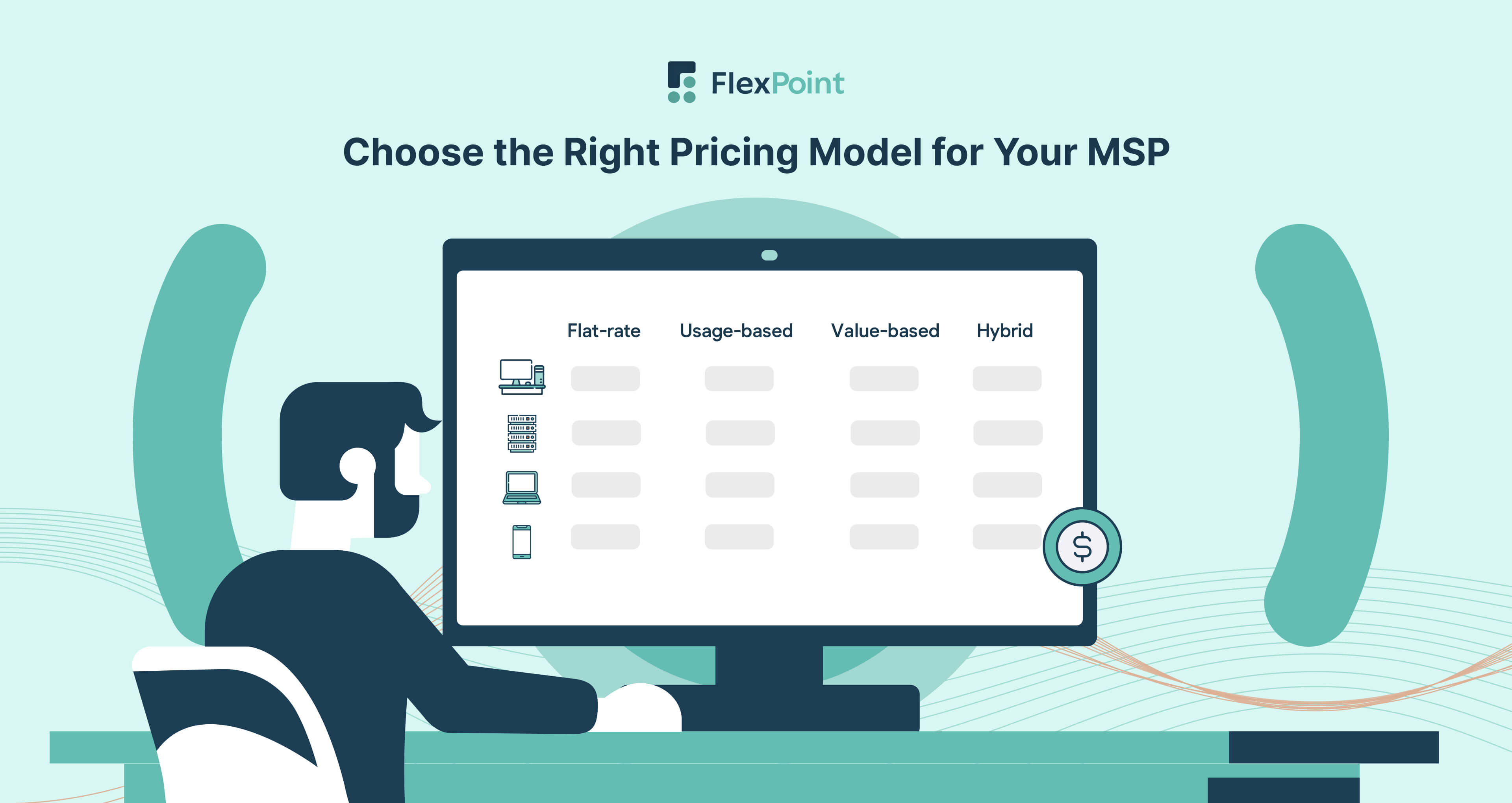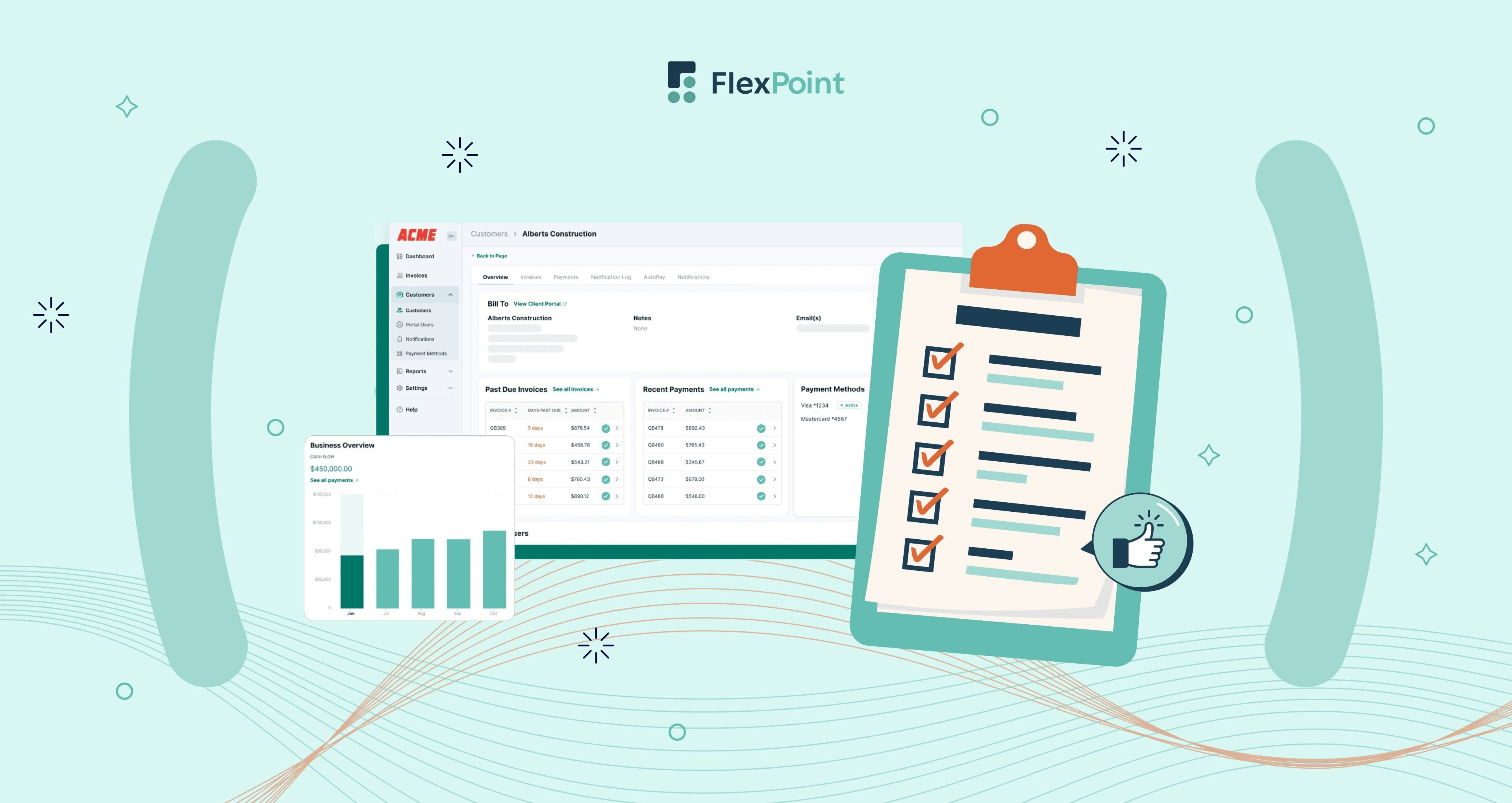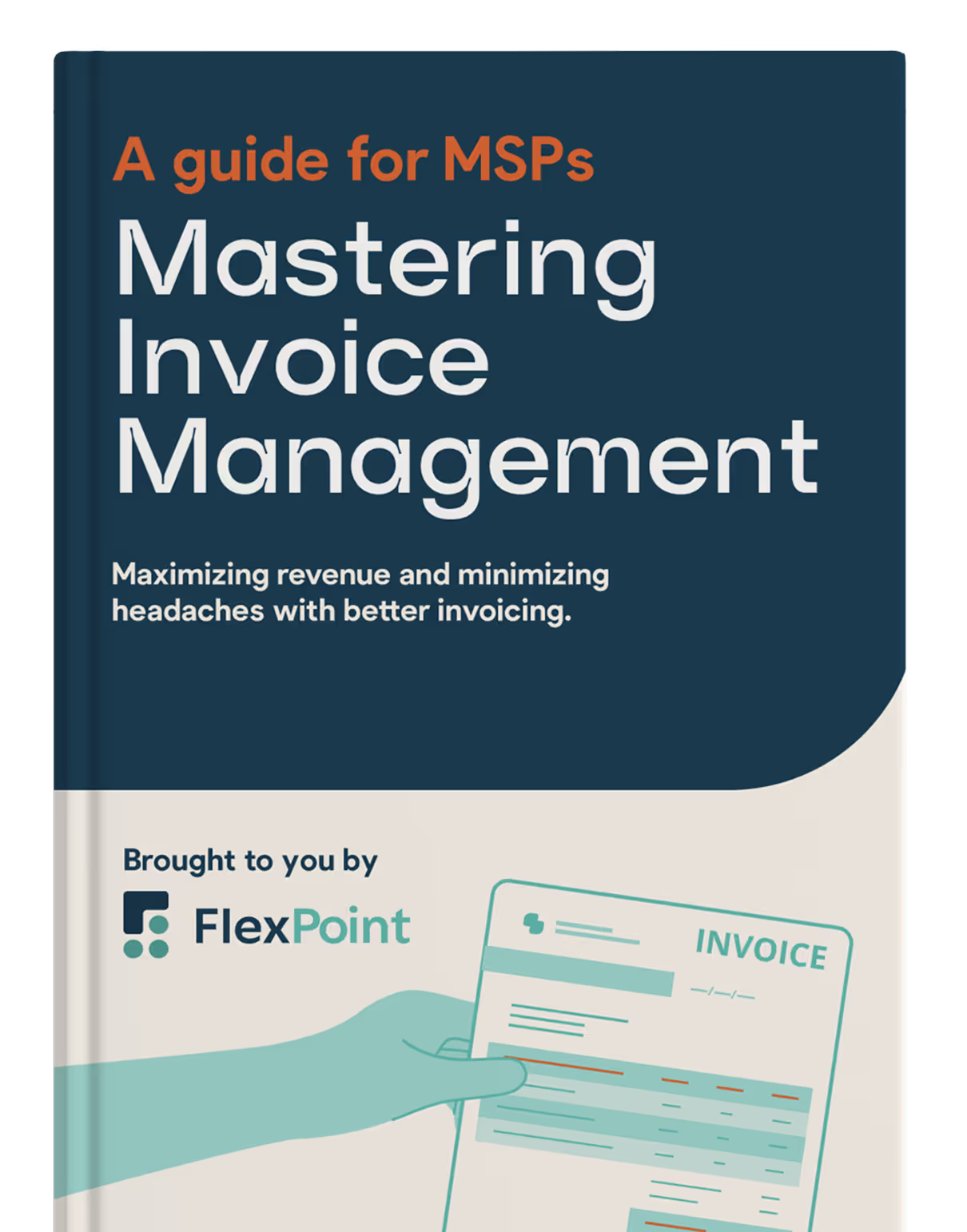MSP Billing Automation: How to Streamline Processes and Reduce Errors
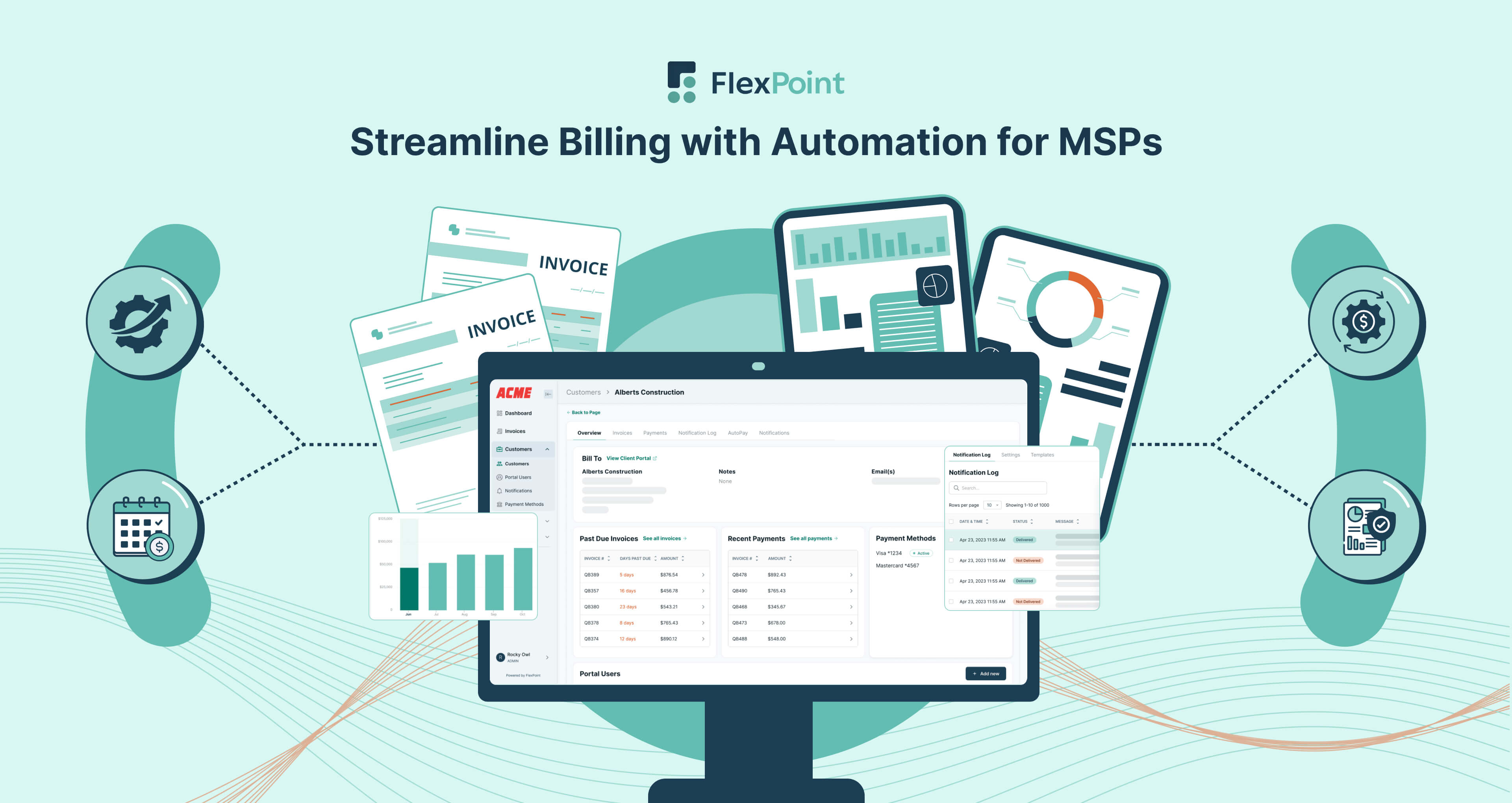
According to Gartner, 18% of accountants admit to making financial mistakes daily, while 59% report numerous monthly errors.
Traditional billing methods rely on manual tasks like invoice generation, reminding clients of payments, and financial reconciliation, which are labor-intensive and highly prone to human error.
These inefficiencies can disrupt cash flow, thus straining client relationships and limiting MSP business growth.
Billing automation offers a game-changing solution. It empowers MSPs to streamline operations, enhance accuracy, and reduce administrative burdens.
By automating repetitive tasks such as invoicing, payment tracking, and financial reporting, MSPs can minimize errors, save valuable time, and deliver consistent, professional billing processes.
The result is improved operational efficiency, optimized cash flow, and strengthened client trust through transparent and error-free financial interactions.
In this article, we’ll explore why MSPs must embrace billing automation and its benefits. Additionally, we provide a practical guide for smoothly integrating billing automation tools into your systems, helping your business grow and scale efficiently.
{{toc}}
Why MSPs Should Embrace Billing Automation
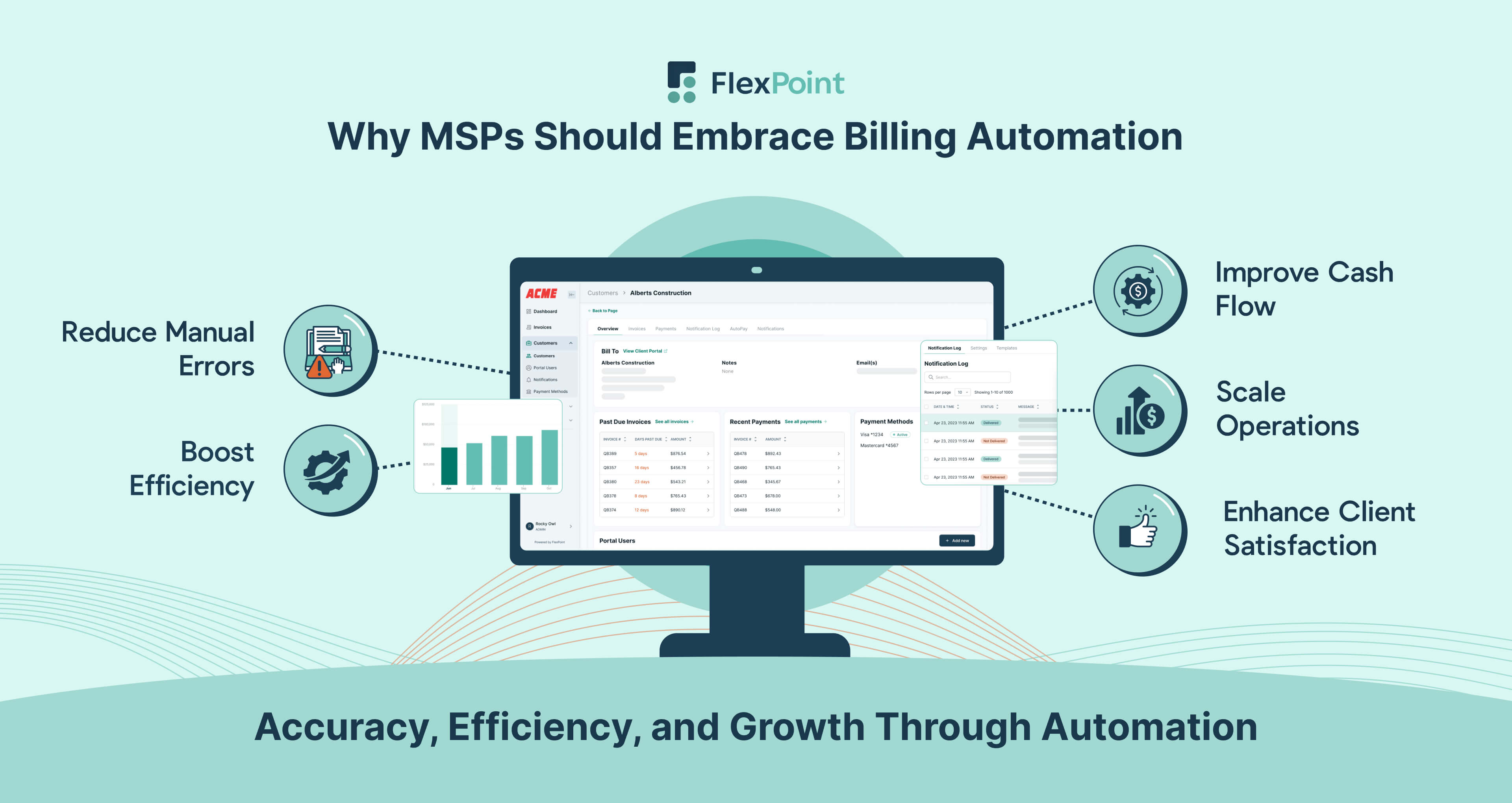
Billing automation is essential for MSPs to thrive in today's dynamic business environment.
Here's why:
- Reduction in Manual Errors: Manual invoicing and payment tracking are error-prone. Manual processes have an error rate of up to 12.5%. According to Docuclipper, humans make 100 and 400 errors per 10,000 entries, while automated systems make just 1 and 4.1. Billing automation eliminates manual data entry, ensuring accurate invoices, timely payments, and precise financial records. This reduces errors, saves time, prevents billing discrepancies, and strengthens client relationships.
- Increased Operational Efficiency: Manual billing and payment processes are time-consuming, taking up to 80% longer than automated systems. However, automated billing and payment processes streamline operations and eliminate the need for undertaking repetitive tasks. By automating billing, you can simplify operations, save resources, and focus on client service and business growth.
- Improved Cash Flow Management: When MSPs use a manual invoicing system, they face cash flow issues due to slow payment cycles and overdue invoices. 68% of companies struggle when payments are delayed. Billing automation software ensures that invoices are sent on time and reminders are based on set rules. It also tracks payments and offers flexible billing. This ensures faster payments, fewer overdue invoices, and steady cash flow for operational stability and growth.
- Scalability: As MSPs grow, manual billing becomes unsustainable. 90% of MSP leaders see automation as the key to scaling their business. Billing automation streamlines the billing process for more clients and transactions without adding to the administrative burden, allowing MSPs to grow while maintaining smooth operations.
- Enhanced Client Satisfaction: Inaccurate and inefficient billing can harm client relationships, with 61% of customers leaving due to poor experiences. Automation improves transparency in the billing process, which customers appreciate. It also speeds up billing, ensuring a quicker, more efficient process.
{{ebook-cta}}
5 Key Features and Benefits of Billing Automation
Billing automation offers numerous advantages for MSPs.
Here's an overview of its essential features and how they benefit MSP operations:
1. Automated Invoicing and Payment Reminders

According to a report from Goldman Sachs, switching from manual to automated invoice processing can reduce the processing time by 70-80%.
Automated invoicing streamlines the billing process by generating accurate invoices based on pre-defined terms.
Additionally, automated payment reminders ensure clients receive timely, personalized notifications about upcoming or overdue payments.
These features help eliminate errors and delays associated with manual processes, leading to faster payments and minimizing the risk of overdue accounts.
For example, an automated system can instantly email invoices upon creation, track real-time payment statuses, and schedule follow-ups for unpaid invoices.
By maintaining consistent communication, MSPs can improve cash flow and ensure better financial stability.
2. Integration with PSA and Accounting Tools

MSP business owners agree that integration is essential for smooth operations.
Payment integration allows systems like ConnectWise, Autotask, SuperOps, HaloPSA, QuickBooks Desktop, QuickBooks Online, and Xero to automatically sync service details, invoices, and payments.
This bi-directional integration eliminates manual data entry, reduces errors, and ensures a seamless billing process.
For example, when a service is completed, the system can instantly generate and email the client an invoice while updating financial records for real-time reporting.
By streamlining workflows, payment integration enhances reporting accuracy, boosts operational efficiency, and enables better financial decision-making.
3. Customizable Billing Models
Automated billing software supports various billing models, including recurring, usage-based, and project-based billing. This makes it easier for MSPs to manage diverse client needs.
An automated system can generate invoices based on specific pricing structures, such as monthly subscription fees for recurring services or hourly charges for usage-based agreements.
For instance, an MSP providing IT support can automatically track service hours, generate invoices, and manage payments, all without manual intervention.
This flexibility ensures accuracy, promotes client transparency, and improves cash flow predictability.
By automating billing, businesses streamline operations, enhance client satisfaction, and stay competitive in a dynamic market.
4. Real-Time Reporting and Analytics

According to a Bottomline survey, 64% of businesses improved productivity, and 35% reduced costs using payment analytics.
These systems allow MSPs to make informed decisions by generating detailed reports on revenue, expenses, and client payment history.
For example, analyzing an accounts receivable aging report alongside cash flow projections can help prioritize overdue payments and reduce the risk of cash flow disruptions.
With dashboards tracking trends and cash flow/payment patterns, you can optimize pricing, allocate resources effectively, and plan for growth, staying agile in a dynamic market while boosting profitability.
5. Enhanced Security and Compliance
According to the AFP Payments Fraud and Control survey, 80% of businesses were affected by payment fraud in 2023.
Billing automation is critical in protecting sensitive financial data and ensuring compliance with industry regulations.
Automated systems safeguard client information using advanced security features such as data encryption, role-based access controls, and secure payment gateways.
These systems help MSPs comply with standards like PCI DSS and SAQ-A, minimizing the risk of penalties and legal complications.
For example, automated payment systems create audit trails that track and document transactions, simplifying compliance and making regulatory reporting more efficient.
By prioritizing data security and compliance, billing automation strengthens client trust, enhances MSPs' reputation, and significantly reduces vulnerabilities to fraud and breaches.
5 Steps to Implement Billing Automation in MSP Operations
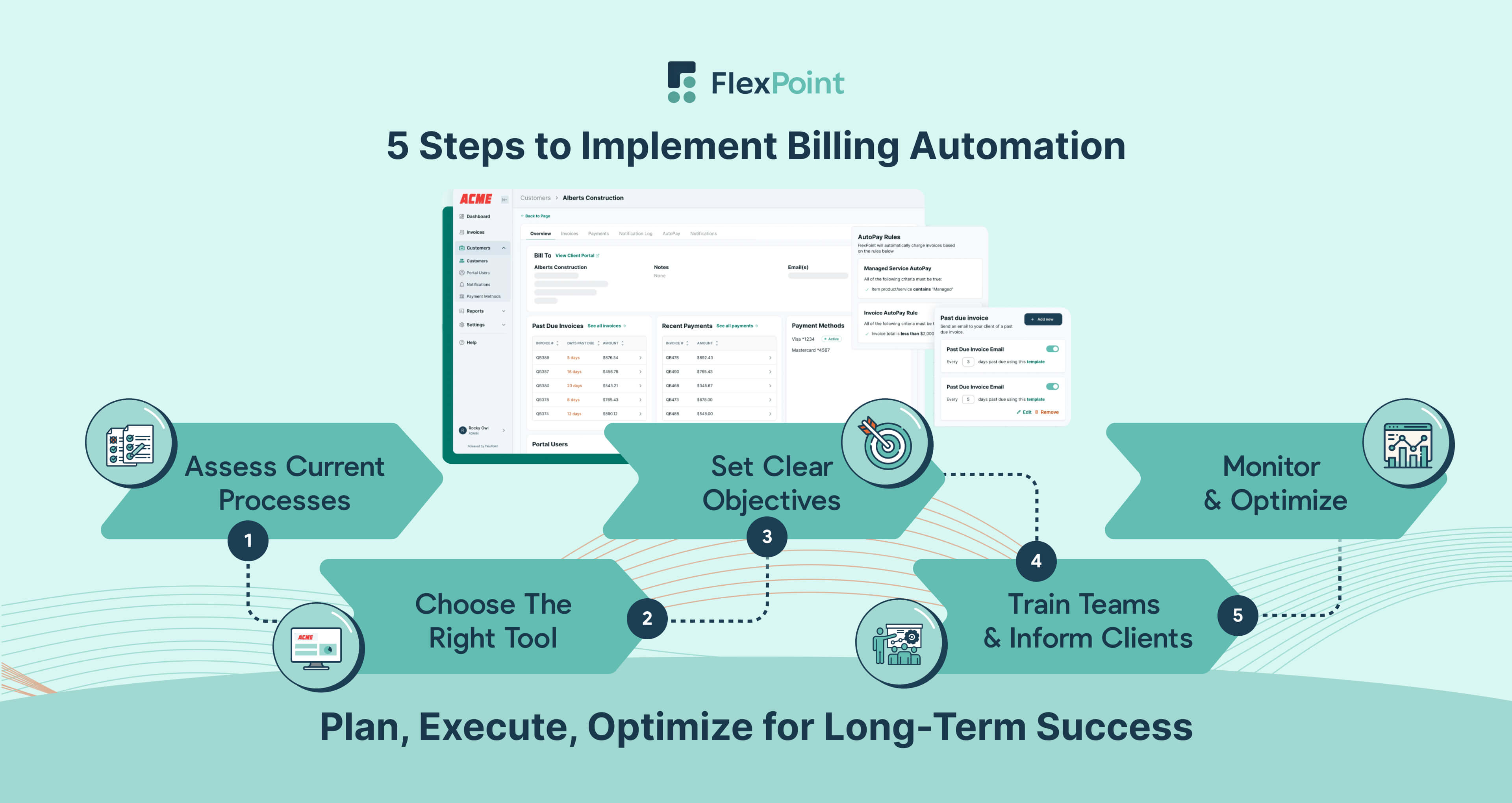
Implementing billing automation can transform your MSP's financial operations. However, careful planning and execution are essential for a successful implementation.
Here's a step-by-step guide:
1. Assess Current Billing Processes
Before implementing a new billing system, assessing your current processes is essential.
Identify bottlenecks, repetitive manual tasks, and areas prone to errors to uncover opportunities for improvement and set realistic automation goals.
For example, this assessment will highlight inefficiencies and potential errors if your MSP relies on spreadsheets to track service hours and generate invoices.
Documenting these challenges provides a clear baseline for measuring the impact and benefits of automation.
2. Choose the Right Automation Tool
Choosing the right billing automation solution is crucial for ensuring it aligns with your MSP's unique needs and integrates seamlessly with your existing tech stack.
Consider your client base size, service complexity, payment methods, and budget when evaluating options. Research different billing automation platforms and compare their features, pricing, and integration capabilities.
Look for solutions that offer key features like automated invoicing, payment reminders, customizable billing models, and robust reporting and analytics.
To identify the best MSP-specific billing automation software, seek recommendations from fellow MSPs or explore online reviews and customer testimonials.
3. Set Clear Objectives
To track progress and demonstrate the value of billing automation, define specific and measurable goals.
These objectives include reducing invoice cycle times, minimizing errors, and prioritizing cost-effective payment methods.
For instance, if your goal is to shorten invoice cycle times, set a target reduction percentage within a defined timeframe.
Clear objectives provide a structured roadmap for implementation and allow you to measure the success of your automation efforts effectively.
4. Train Teams and Communicate with Clients
Train your staff on the new automated billing system to ensure a smooth transition.
It also provides comprehensive training, communicates the benefits of automation, and addresses any concerns to foster a positive attitude toward change.
Transparency is also key when informing clients about the shift to automated billing. Highlight the benefits they will experience, such as simplified payments and improved communication.
For example, offering resources and support can help clients navigate the new system and address any questions.
5. Monitor and Optimize
Continuous monitoring and optimization are essential to maximize the benefits of billing automation.
Review your automated billing workflows regularly, track key performance indicators (KPIs), and identify areas for improvement.
Analyze invoice payment times, delays, and client communication data to refine your processes.
This ongoing approach ensures that your billing automation system adapts to your business needs, remaining efficient and effective.
Conclusion: Transforming MSP Billing with Automation
In this article, we discussed how billing automation revolutionizes MSP operations by reducing manual errors and enhancing cash flow management through features like automated invoicing and real-time analytics.
We further provided a step-by-step guide that MSPs can use to implement a seamless billing process.
If you face challenges with traditional billing methods, explore automation as a powerful solution.
An automated billing platform addresses inefficiencies, minimizes errors, and offers greater control over financial processes. It enables MSPs to scale their businesses quickly. With the right automation tool, you can significantly improve billing accuracy, operational efficiency, and client satisfaction.
FlexPoint's billing automation tools are designed to simplify the transition to billing automation.
With its seamless integration with PSA and accounting systems and advanced automation features, FlexPoint ensures you can manage your billing processes more effectively while maintaining strong client trust.
For instance, WJP Technology Consultants, a Texas-based cybersecurity and IT services MSP, faced challenges with its previous billing system, including high costs, poor support, and complex client onboarding.
Switching to FlexPoint transformed their operations by automating billing and integrating seamlessly with tools like QuickBooks.
FlexPoint simplified invoicing, recurring payments, and client tracking, reducing manual work and saving time. Its user-friendly client portal lets customers quickly set up accounts, store payment methods, and enable AutoPay.
With these improvements, WJP saw the payment process 3x faster, a 30% increase in AutoPay adoption, and a 15% cost savings.
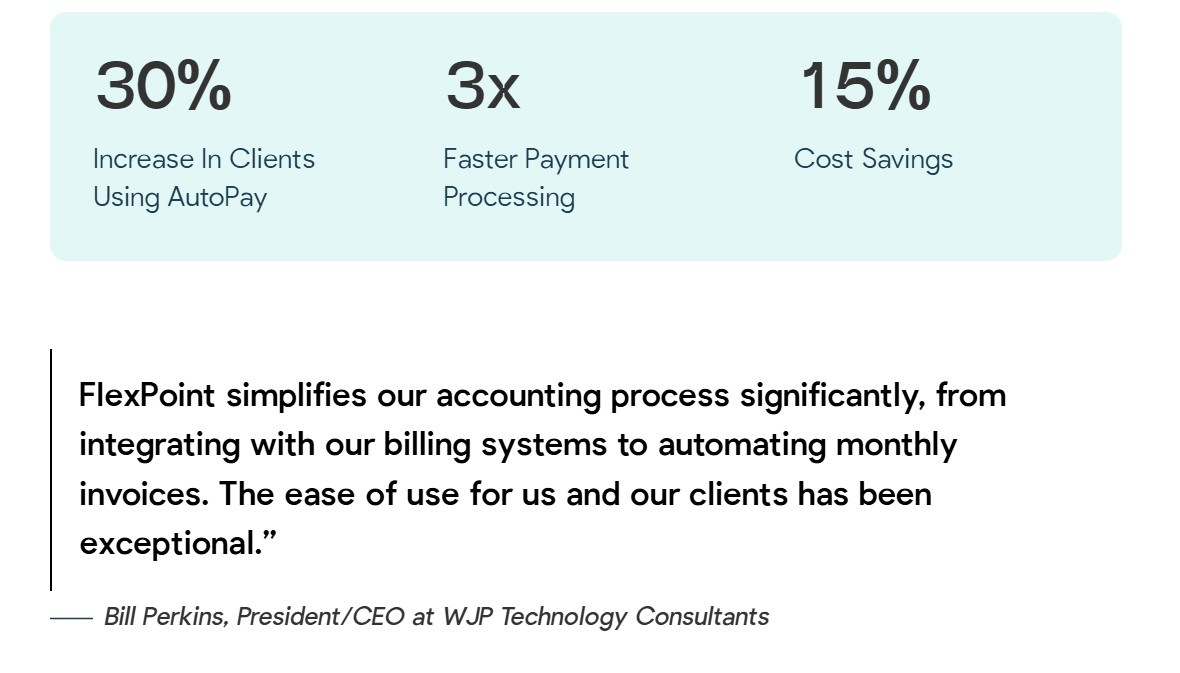
Streamline your billing operations and unlock efficiency with automation. Ready to transform your MSP's financial processes?
Schedule a demo today to see how FlexPoint can revolutionize your business.
{{demo-cta}}
Additional FAQs: MSP Billing Automation
{{faq-section}}



